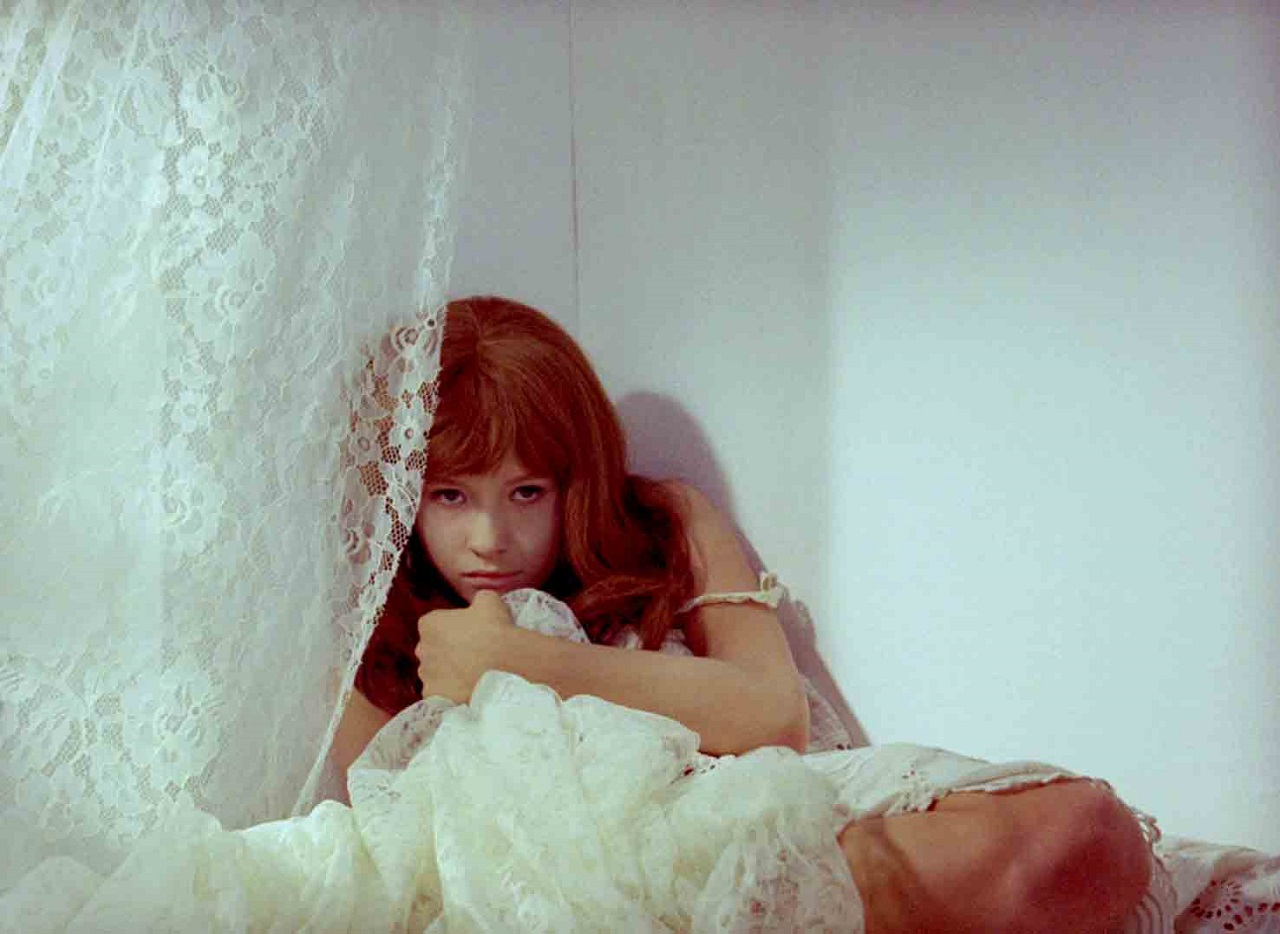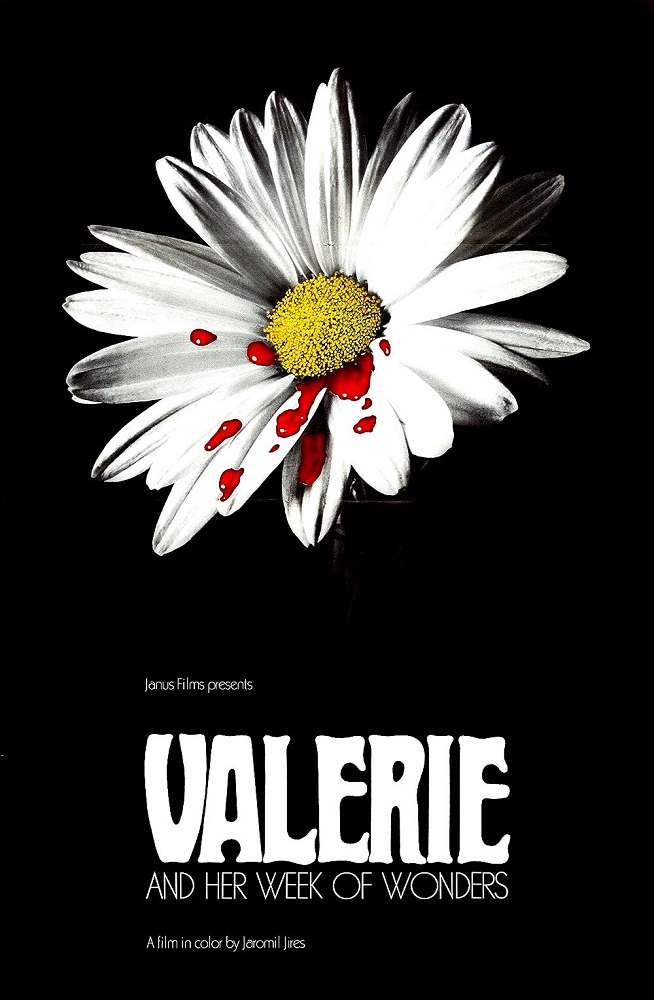(Valerie a T’Den Divu)
Crew
Director – Jaromil Jires, Screenplay – Jaromil Jires & Ester Krumbachova, Dialogue – Jiri Musil, Based on the Novel Valerie and Her Week of Wonders (1945) by Vitezslav Nezval, Producer – Jiri Becka, Photography – Jan Curik, Music – Lubos Fiser & Jan Klusak, Production Design – Ester Krumbachova. Production Company – Studio Barrandov.
Cast
Jaroslava Schallerova (Valerie), Helena Anyzova (Grandmother/Elsa/Redhead/Mother), Petr Kopriva (Orlik/Eagle), Jiri Prymek (Weasel/Richard), Jan Klusak (Reverend Father Gracian), Alena Stojakova (Hedvika), Martin Wielgus (Father)
Plot
Young Valerie has grown up with her grandmother. After being presented as a virgin in a ceremony at the church, the priest acts in a sinister manner towards her. She is informed that she is the daughter of a bishop. She spends her time with Orlik or Eagle and they both love one another but she is then told that they are brother and sister. Another priest comes to stay and appears to be a vampire but also may be her father who has returned. Valerie tries to avoid the clutches of those who appear to be vampires.
Valerie and Her Week of Wonders is a film that has a small appreciative audience. It was acclaimed when it first came out and made appearances at a number of international film festivals. Thereafter it seemed to languish forgotten, although was rediscovered in the 2000s and a new print screened at festivals and it re-released to dvd. It has also been the subject of various screenings where bands have performed live music.
The film was adapted from Valerie and Her Week of Wonders (1945) by Czech surrealist writer Vitezslav Nezval, which has a modest reputation as a classic in its own country, although not so much in English language. The film adaptation was conducted by Jaromil Jires, a director of controversy during the 1960s with works like The Cry (1964) and in particular The Joke (1969), which caused upset with its satirical jibes at the then-ruling Czech Communist Party. Jaromil Jires worked regularly as a director until his death in 2001, although most of his films did not screen outside of the Czechoslovakia/the Czech Republic. He made two other ventures into genre cinema with A Big Plate of Malikov (1977) in which a UFO visits a rural Czech village and Double Role (1999) in which the brains of an old woman and a young street kid are surgically swapped.
Much of Valerie and Her Week of Wonders sits on the edge of a child-like innocence – a virginal girl’s dream of the world around her, of rituals of Catholic Confirmation, with her dressed in white and everything shot with a misty gauzed-out lens. In the film’s constantly drifting and hazily surreal narrative, Jaromil Jires leaves the film as one that is half dream, half real with the lines in between constantly being blurred.

It is a world that seems to loom with threat, particularly of a suggested sexual nature. There are male figures that are constantly seeming something else – a man in an animal mask in the marketplace; the priest who becomes an albinoid figure in a black hood and tries to molest Jaroslava Schallerova; the character that blurs between being a vampire and it later appears may be Valerie’s father or else a priest who has come to seduce her mother. Elsewhere there is the character of a local woman (Alena Stojakova) who gets married and this rapidly turns into a nightmare. Valerie spends much of her time with Ortik or Eagle (Petr Kopriva) who is said to be her brother but the relationship looks to us more like it is one of girlfriend and boyfriend.
The film constantly hovers on the verge of a girlish innocence where the fear of blooming sexual maturity represents a dark threat that keeps intruding. There is no particular plot to the film – it is one of those art films where the shifting nature of the plot is an affect in itself. Jaroslava Schallerova has an extraordinary beauty and perfectly embodies the quality of a girl who sits on the cusp of being a woman.
Vitezslav Nezval intended his book as a homage to the imagery of 19th Century Gothic horror and similarly the film plays with horror imagery – the vampire father (Jiri Prymek) resembles Max Schreck in Nosferatu (1922), for instance. Valerie and Her Week of Wonders has been compared to the adaptation of Angela Carter’s The Company of Wolves (1984), which similarly features the dark fantasies/fears of male sexuality being had by a young girl sitting on the edge of sexual maturity and swam between dream and reality on multiple levels. The other film I kept being reminded of was Philip Ridley’s The Reflecting Skin (1990) and its child-like take on the American Midwest and its surreal swim between child’s literalistic interpretation of metaphor and adult things not fully understood.


